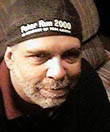|
|
 
|
|
Author
|
Topic: Backvac woes
|
|
|
|
|
|
|
Randy Stankey
Film God

Posts: 6539
From: Erie, Pennsylvania
Registered: Jun 99
|
 posted 11-15-2010 10:27 AM
posted 11-15-2010 10:27 AM




I am THE BITCH when it comes to coiling up cords!
AFAIAC, there is but one way to keep cords from being damaged. That is to coil them properly each and every time after they are used.
Working on stage, there are countless cables, cords, ropes and feeders to be uncoiled, used, coiled up again and stored. We have microphone cables, extension cords, speaker cables, ropes, hoses and power cables. If you don't use them properly, they will break and become useless in a very short time.
Done properly, you can literally hold on to one end of a coiled line, toss it out and have it end up lying flat on the floor in a straight line. Done wrong, you'll have macramé.
When you are responsible for teching a show, there are always last-minute requests for microphones and things. If you take care of your cables, it is a simple matter to plug in one end of the line, pay it out as you walk then set the mic stand in place and plug the other end in. You can have your microphone or other equipment in place and working in a matter of seconds if you do it right. Otherwise, you look foolish, especially when a lecture or concert gets held up because you are untangling a cord or troubleshooting a broken connection.
I tell people, all the time, that there is no "secret knowledge" to working on the stage. 90% of the time, the only "secret" you need to know is to stay organized in the first place. When you are faced with that inevitable last-minute situation, you will be able to deal with it quickly and efficiently. If you are not prepared, you will look like an idiot.
There are countless times when I holler at Work Study students or part time stagehands about coiling cords. I have caught people winding cords around their elbows and hollered across the stage at them. They invariably roll their eyes at me and act like it doesn't matter.
The person usually complains that it's "too hard" to coil cables correctly. When they complain, I often will pick up another cable and demonstrate the right way to coil it, throw it out flat then recoil it before they are done finished wrapping their cable the wrong way. I usually do this demonstration with my eyes shut just to show them how easy it can be if you do it right.
It only takes a little bit of practice to learn how to coil a cable the right way. When you learn it and do it right, it can be faster and easier than doing it wrong. At the end of the day, you are finished with your job faster and the work is better. Then, when it comes time for the next job, you are all ready in position to do the task at hand without fooling around.
So, my suggestion is to MAKE people do it right. Holler, scream, stomp your feet at them and make their lives miserable until they learn.
If I catch people wrapping cables instead of coiling them after they have been "lectured" how to do it right, I have been known to make them go into the equipment room and recoil every cable and organize them on the hooks in order of their length.
If they repeatedly do it wrong, I threaten them by showing them the sawdust bin underneath the table saw and tell them that they can either do it right or they can shovel sawdust.
Given a choice, most of your average college student will do anything to avoid that job!
Cord reels might help but they are and expense. If you use them you STILL have to wind cables up correctly to prevent tangling and damage. It my advice to dispense with reels and just KILL anybody who does not take proper care of your equipment.
| IP: Logged
|
|
|
|
|
|
|
|
Frank Angel
Film God

Posts: 5305
From: Brooklyn NY USA
Registered: Dec 1999
|
 posted 11-23-2010 01:27 AM
posted 11-23-2010 01:27 AM





The Over Under winding method is so simple that it's amazing you see so many people who work in A/V, on stage, or in any kind of production who simply do not to coil cables. And not coiling the properly isn't just an Emily Post nicety, doing it incorrectly is detrimental to the cable itself.
Here is a link Over Under Method. This is a decent demo of the Over Under method -- the ONLY way cable should be wound.
As you can see in the demo, a correctly wound cable can be unwound quickly and without any kinks at all, every time -- you throw it out and it unravels perfectly as one straight piece of wire. And as you can see when he is doing it at his normal speed, not demonstrating, the Over Under method is absolutely just as fast as any WRONG way of coiling a cable -- that wrapping around the forearm being just the worst thing you can do to cable.
As Randy says, if you get a cable that is badly kinked, you may need to stretch it out and force it to untwist opposite the kinks and that may take a few times, or as he did, stretch it out in the sun on the driveway. But once that is done and it is wrapped U/O EVERY time from then on, it will be made whole again.
Winding incorrectly builds kinetic energy forces into the cable that weaken it, especially at the connectors, and will shorten its life.
In this video he his is using video cables because their construction is more susceptible to incorrect winding which goes against the natural internal construction, but the Over Under method should be used on ANY cable, coax or mic or even simple AC extensions. FORCE anyone who you are responsible for to learn how to do O/U and don't let them touch cable until they get it, just like you wouldn't let them touch a splicer until they learned how to properly make splices.
And to finish, I highly recommend the Velcro cable ties. They are fast, always attached to the cable and hold the correctly wound roll together. I know, they are a bit more expensive certainly than tieline, but tieline in the hands of some brute of a bear stage hand can be tied so tightly around the neck of the cable where it normally is attached -- very close to the XLR or other connector, that it can put unnecessary stress there.
Over Under -- good for cable winding, good for Technicolor 35mm 3D! ![[Razz]](tongue.gif)
| IP: Logged
|
|
|
|
|
|
|
|
|
|
|
|
|
|
|
|
All times are Central (GMT -6:00)
|
|
Powered by Infopop Corporation
UBB.classicTM
6.3.1.2
The Film-Tech Forums are designed for various members related to the cinema industry to express their opinions, viewpoints and testimonials on various products, services and events based upon speculation, personal knowledge and factual information through use, therefore all views represented here allow no liability upon the publishers of this web site and the owners of said views assume no liability for any ill will resulting from these postings. The posts made here are for educational as well as entertainment purposes and as such anyone viewing this portion of the website must accept these views as statements of the author of that opinion
and agrees to release the authors from any and all liability.
|

 Home
Home
 Products
Products
 Store
Store
 Forum
Forum
 Warehouse
Warehouse
 Contact Us
Contact Us




 Printer-friendly view of this topic
Printer-friendly view of this topic










![[Roll Eyes]](rolleyes.gif)
![[thumbsup]](graemlins/thumbsup.gif)

![[Razz]](tongue.gif)







